有关1.11版本前的后勤系统,请参考本页面的历史版本。
在钢铁雄心4中,后勤(Logistics)是指将战斗人员(增援)和装备送到需要的地方去,以此来支持作战部队,同时确保作战单位所在地的补给水平足够他们有效率的行动。其中最重要、最复杂的元素就是在1.11版本(“巴巴罗萨”补丁)大改的补给系统。
补给
补给本身并不是生产出来的,省份的补给水平代表了对作战部队的“支持限度”(可以把它看成是一种柔和的单位堆叠限制)。每一个陆战单位自身也有一个内部的补给状态,和其所在省份的补给水平相独立,但两者之间也有关连。
一个省份的可用补给来源于三个不同的部分:“补给中心补给(Hub Supply)”、“空投补给(Aerial Supply)”和“地区补给(State Supply)”。补给中心的补给是通过补给网络从一个国家的首都运输到此国前线作战部队的。而补给网络则由补给中心、港口、铁路和运输航线构成。空投补给是由执行空投任务的运输机提供的,仅对其空投的空域有效。地区补给则是指每个地区都有的一个固定的补给量,所有作战单位都可以从所在地区中获得补给(如果是一个还没有被某一方所完全占领的地区,该地区的补给则由占领的数方部队共享)。
- 值得注意的是,即使一个作战单位能从补给中心获得所需的全部补给,他依然会从所在地区的补给当中抽取一部分。实际上,他们会优先使用地区补给,其次使用补给中心的补给,最后才使用空投的补给。
只要作战单位所需的补给总量小于所在省份能提供的补给量,那么这些作战单位就能完全补给。相反,则这些作战单位将承受惩罚。下面将会详细介绍。
补给地图

The two crates in the map mode selection area in the bottom-right of the screen indicate the supply map mode.
补给情况在游戏中主要通过供应地图模式显示。在默认设置下,可以通过按下"F4"键或在屏幕右下角选择补给地图模式图标来访问此模式。
补给地图通过不同的着色来展示每个省份的供应状况。这些颜色渐变使得同时查看数百个省份的补给情况时也能一目了然。
- 亮(浅)蓝色:有大量可用的补给
- 深蓝色:有少量可用的补给
- 紫色:有少量或没有可用的补给,但该省份的部队没有受到低补给的影响。
- 黄色:该省份的部队补给供应部分不足,但仍有足够的补给让部队不至于受到严重的debuff。
- 亮红色:该省份的部队补给供应严重不足,它们正遭受重大的补给相关惩罚。
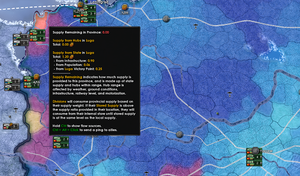
在莫斯科周围,供应充足的省份是亮蓝色的,而在更远的地方,它们变成了深蓝色。一些边境省份的补给供应不足(比如选中的这个省份),该省没有剩余的供应,无法完全供应驻扎在那里的部队,它们用明亮的橙色表示。紫色省份的供应量很低或没有可用的供应,但没有部队驻扎。
补给地图模式中的工具提示非常有用,将鼠标悬停在不同物品上会显示不同的信息:
单位: 单位补给消耗,以及补给的来源。
补给中心: 补给中心需要的补给量,并突出显示连接首都的铁路。按住 Shift 键会显示补给中心的范围(当时--范围会随天气变化)。
港口: 补给中心所需的补给量,并显示可能从港口提取枢纽(但非国家)补给的任何船只的路径。按住 Shift 键会显示补给中心的范围(当时的范围--范围会随天气变化而变化)。
省: 某省的总供应量和可用供应量。按住 CTRL 键还会显示枢纽补给的来源明细。
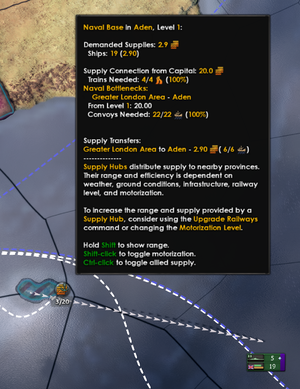
Hovering over the port on the island to the South-East of the Arabian Peninsula also brings up arrows to ships supplied by that port, as well as a tooltip containing much useful information.
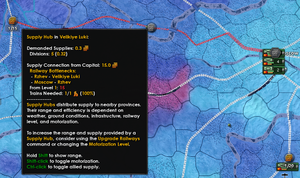
Bringing up the tooltip for the supply hub of Velikiye Luki highlights in red the rail connection to the capital, while the tooltip provides a range of information on the nature of the hub.
后勤
补给中心
中心补给是给补给中心或者港口提供补给 (激活的补给中心, 港口也一样),我们关注中心补给时有3个要素需要注意:
- 一个补给中心的可消耗的总容量。
- 补给中心的范围,和一个特定省份补给中心补给量。
- 一个特定省份收到的补给来源于所有范围中的补给中心。
大多数情况下,在写文本时,最常见的供应问题是基于特定省份的不充足的供应,不是总供应量不足。
总补给中心补给能力
补给中心/港口的总吞吐量基于与首都相连不同等级的铁路相连的补给中心/港口,首都之间,港口之间的铁路水平(包括车队的到达和离开)
与首都相连的一个补给中心的一级铁路为该补给中心提供了一个基本15的供应吞吐量,每个增加等级铁路建筑吞吐量增加5,直到最大值35。等级1的港口与其他等级的港口供应,收到的港口基础是8补给。每个增加的港口等级建筑会增加3的补给吞吐量,直到最大35。注意:如果护送车队供应中的港口被袭击,供应提供量会被减少直到铁路被恢复其容量,此外,供应生产量的上限基于最小的铁路或港口供应量在任何一个相连的店(所以,举个例子,如果有3个铁轨,2个等级2,1个等级1,相连被认为是一个1级相连同时有15的补给,直到升级到等级2相连会有20的补给量,等级1的铁路会需要升级到等级2)(另一个例如,如果有3个铁路相连到等级6的港口到一个等级5的港口,链接被认为是一个等级5的相连并提供20的供应)。河流可用作一级铁路连接。
每级港口提供的补给量
| 1
|
2
|
3
|
4
|
5
|
6
|
7
|
8
|
9
|
10
|
| 8
|
11
|
14
|
17
|
20
|
23
|
26
|
29
|
32
|
35
|
每级铁路补给量
一个例外是这个首都的补给中心,它的吞吐量基础是5,然后一定量的民用工厂和军用工厂和造船所。
补给中心供应范围
补给中心供应给每个身份基于许多因素,最重要的是省份之间提供存在的补给中心,这个存在的修正主要是铁路连接的等级去供应来自首都的补给中心,基础设施(指所有可以建筑)的水平。
地形,和 天气.

看看屏幕截图“来自补给中心”价值,随着距离的增加,来自补给中心的供应价值减少。注意,地区弹出的提示是该省份地区所在的地区,不是省份连接的补给中心提供的来源。(最右边的提示,仍然写着供应来自Akhtubinsk)。
提升补给范围
除了空中补给以外,给一个省份提升补给水平是在整个游戏的过程中,几乎总会完全的由于改善了补给中心的供应量。下列4个方法可以提升。:
- 增加补给中心的机动化水平或是军队的(军队的补给机械化指令)
- 增加铁路链接到补给中心的等级。
- 增加地区的基础设施等级。
- 建造一个新的补给中心
注意,前三种方法(机械化,增加铁路连接等级和增加基建等级)总是可以叠加-所以一个摩托化补给中心是一个地区有1级基础建设和1级的铁路相连将会有最小的供应范围,当一个完全的摩托化补给中心和5级基建和5级铁路相连,会有最大的补给范围。
非常重要的一点是关心补给中心供应,分散开来可以显著的增加,特别是来自更多的补给中心和港口,或首都-------增加补给范围,分别建设的改变也许相对较小,经常投入大量的投资可以增加范围也许会足够推进他从中心到下一个省份。
摩托化
默认情况下,每个补给中心设置成非摩托化,图片是一个马。这是个可以提升到2个不同的摩托车,单击可以让他变成运转图标(看举例的图片)。一旦一个中心摩托化后,图标会变成1个或者2个小卡车(基于于摩托化水平),一个绿色或者更多的卡车表示,这个补给中心直接描述的摩托化,当灰色卡车表示,它已经变成摩托化并支援了附近的军队---更多的在下面。注意补给中心变成卡车赋值摩托化,无论是否直接的经由补给中心或选择摩托化,选项,都不会消耗燃料或人力。
依赖于摩托化的等级,每个补给中心需要0,40,或80的卡车(图片为,马,1辆车,2辆车)
这些卡车损耗,在恶劣的 地形和天气下增加,它们也会受到来自敌人飞机的后勤打击任务

Observe the changing icons as the level of motorisation of the Odessa supply hub (port) is increased. As per the far-right image, as long as a hub is motorized, it will have an icon of one or two trucks to indicate this (the number of trucks indicating the level of motorization).
其他方式达到补给中心摩托化,在军队等级去分配它。这将自动切换在军队获取补给品的范围内的枢纽上为军队设置的机动化水平。这一优点是降低了枢纽机动化水平的微观管理,但它可能导致对军队的需求波动,因为军队范围内的枢纽数量随着时间的推移而变化。请查看下面的三个截图和说明
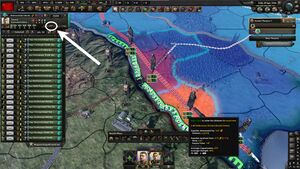
In this example, the troops at Tiraspol, to the north-west of Odessa, aren’t fully supplied. While the level of supply isn’t critical, one way to improve the level of supply would be to increase the level of motorization of the army (is currently set to “not motorized”, as indicated by the “horse” highlighted by a white ellipse and arrow in this screenshot).
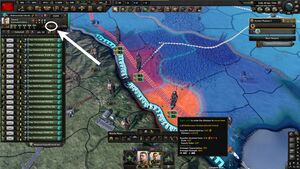
The army has now selected the first level of motorization, again highlighted by a white ellipse and arrow), and the supply situation for the troops at Tiraspol has improved considerably. Also note the small grey truck that is now part of the icon for the Odessa supply hub.
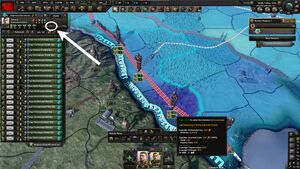
The army has now selected the second level of motorization, again highlighted by a white ellipse and arrow), and troops at Tiraspol are now fully supplied. Also note that the grey “truck” icon that is part of the Odessa supply hub icon now has two trucks in it.
请注意,只有在有足够的卡车时,才会得到机动化的全部好处。如果分配给支持枢纽的卡车比可用的要多,那么收益将会减少,与卡车的短缺成比例。
File:Supply-015.jpg While Rokossovky’s army has full motorization toggled, because of the shortage of trucks (note the tooltip), the troops at Tiraspol are not fully supplied.
提高铁路等级
在摩托化之后,增加铁路链接等级是下一个最有力和常见中最快的(但它取决于如何离你的首都和铁路供应补给中心有多远)
File:Supply-016.jpg To find out the level of the rail connection between a hub and the capital, hover over the hub in the supply mapmode, and see what the tooltip says about the bottleneck. In this case, Akhtubinsk is limited by its railway connection only being level 2, for the entire path from Moscow.
每个铁路花费170CIC,+130CIC给每个存在的铁路等级(最大到等级5),所以,它相对最快和最便宜去放置一个等级1的铁路,订单一个长的等级5的铁路是一系列的企业建设。举例说,详见下表,总CIC去建筑铁路来自没有到达5,是2.150CIC每个省份(170+300+430+560+690),修正后的任何建设奖励和基础建设速度影响。
铁路花费 (CIC) 每级, 每个省份
| 铁路等级
|
1
|
2
|
3
|
4
|
5
|
| CIC 花费
|
300
|
430
|
560
|
690
|
820
|
实际上铁路建筑可以有很多种方式:
- 选择补给中心,然后点击中间按钮(顶部)三个显示图标中间,每次点击会提升其他铁路等级到连接到首都的每个省份铁路的连接情况,3次补给连接可以让2级的铁路铺设命令到最大等级
- 开放生存可以让生产界面,和选择“铁路”按钮,然后点击白色按钮中的一个,在黑色圈一个由2个补给中心铁路连接-这会放置铁路建设命令去增加铁路等级在2个补给站中间,每次增加会放置铁路增进等级
File:Supply-017B.jpg Here the supply hub button has been pressed, bringing up the three icons – the one in the middle, highlighted by the arrow, will put in construction orders to upgrade the rail connection to the capital.
File:Supply-018.jpg Here, the “upgrade rail connection to capital” has been pressed for Akhtubinsk – see the construction orders in the construction build queue, as well as the “under construction” icon on the stretches of railway being upgraded in the supply map mode.
File:Supply-020.jpg The “2” between Lipetsk and Tambov highlighted here, indicates that the level of rail connection between the two supply hubs is level 2. Click on this two with the “rail” tool in the production interface selected, and construction orders will be placed to increase the level of the rail connection between the two hubs.
每增加一级的铁路会增加补给中心一定大小的总补给供应,它意味着补给流动从补给中心外流也会增加。在一些情况下也意味着省份可以在没有贸易中心的情况下会收到一些补给中心的补给,如上所述,增加“供应流动下降”更远来自补给中心意味着补给扩张范围可能会受到限制。
File:Supply-019.jpg This series of screengrabs shows the impact on a province on the Soviet border with Finland of incrementally increasing the level of rail connection to the hub from 1 (far-left) through to five (far right) – note the weather is clear, and the hub is not motorized.
请记住,铁路对战略重新部署也很有用,而且铁路水平越高,部队的战略重新部署速度就会越快。
建造新的补给中心
File:Supply-021.jpg Here, Japan selects a supply hub for construction, which they then place it in a province where it will have a useful distribution. Bear in mind supply hub range is by province, not by area, so all else being equal supply will flow from a hub through two large provinces just as well as it will through two small ones.
如果它看起来是没有成本收益,可能,需要建设一个新的补给中心来补给。在海岸上,港口作为供应枢纽,而且要便宜得多(海军基地第一级为5000CIC,后续每级的成本再增加1000CIC)。然而,内陆地区需要使用供应中心,这需要20000个CIC(由任何建设速度和基础设施建设奖励修改)。
港口和供应中心都是使用建设页面的,如下图的截图所示。
港口和补给中心可以在盟国和属国的领土上建造。
如果它可以通过车队、其他港口和铁路追踪到首都,那么一个港口将由海上供应,而不需要铁路连接。
File:Supply-022.jpg Here, Japan selects “railways” in the construction interface, and the clicks on the province to the south-west of where the new supply hub is building, and then clicks on the province containing the supply hub that’s being built.
补给中心也会要求连接到首都,通过铁路或河流进行追踪。通过河流的连接是即时的,可以考虑是否去造一个新的补给中心(与包含供应中心的省份接壤)连接到首都或链接到另一个补给中心,或港口所在的省份
To connect a new supply hub with a rail connection, open the construction interface and select the “railways” option, and then click on a province with a railway that is connected to the capital, and then click on the province with the new supply hub. The level of the railway constructed will be the same as that of the level of the railway in the province that it’s extending from, but this can be manually adjusted down or up levels (as long as the railway hasn’t been built yet) using either the construction list (the +/- buttons on the railway in the list) or on the supply map (left-click on small number (underneath the crossed hammers) on the railways under construction to increase the level, and right-click to decrease the level).
铁路可以在任何时候在控制、盟友或属国领土内建造,并且不需要等待一个补给中心完成(甚至启动)。
File:Supply-023.jpg Improving the level of infrastructure in the state of Arkhangelsk improves the level of hub supply provided at the airbase to the south of the hub. Note that the overall supply in the province increases by significantly more, because infrastructure has both a hub supply range and a state supply effect – more on state supply below.
提高基础设施等级
高等级的基础建设也允许补给从补给中心到更远,该流动补给的供应会直线下降,(对于基于5级基础设施而言最大减少至0.3),注意那个基础设施的等级问题是地区链接省份来自流动供应。所以,举个例子,如果这有2个地区,一个地区有5的基础设施和一个边境省份有一个等级1基础设施的地区。会有流动供应,就像5的基础设施流动到1级的基础设施。
与其他扩大供应中心范围的方式一样,随着距离中心(按省)的增加,供应减少的增加意味着任何增加可能只在边缘(即可能增加一个省的范围)。
请注意,每个基础设施的花费是6000CIC--所以诸如等级4的基础设施在一个省份的花费会超过建设一个新的补给中心
火车
为了充分发挥出效率,供应网络需要铁路相连的火车,类似于的要求像海军连接,火车数量的需求与每个补给中心供应需求相关。火车需求在每个补给中心的提示页可以看到.
Train requirements for the network as a whole can be found in the logistics tooltip, which can be brought up by hovering over the logistics icon at the top of the screen (it looks like a crate with a percentage next to it). If there are less trains than the network requires, there will be a reduction in hub supply available to divisions drawing it.
File:Supply-025.jpg In the first screengrab, the logistics tooltip indicates there are only 58% of the trains required. In the second screengrab, of the Minsk supply hub tooltip, it shows that this results in only 6 of the 11 required trains being available. In the third screengrab, the divisions drawing on hub supply are only partially supplied because of this (note that their overall level of supply is higher than might be expected by the train shortfall because they are also drawing on state supply – more on that below).
File:Supply-026.jpg The research options for both the war austerity train, and the armoured train, can be found at the bottom of the “Support Companies” tab, as highlighted in this screenshot.
Trains are not subject to attrition, but they can be destroyed by air attack from enemy aircraft using logistical strike.
As well as the base model train, two other train models can be researched over the course of the game. One is an unarmoured “austerity” train – which does the same job as the base model, but at a cheaper price (50 MIC instead of 70). The other is an armoured train, more on which below.
装甲火车
装甲列车是一种特殊类型的列车,更能抵抗敌人的后勤打击空中任务。如果你的库存中有装甲列车,它们将自动比其他类型的火车先使用。装甲列车的生产成本要高得多,为105MIC,因此比初始列车贵得多,是简化列车成本的两倍多。
File:Supply-027.jpg In the top screenshot, 100 Polish CAS have been attacking the logistics of Belarus for a week, against a Soviet logistics network that only had unarmoured trains. In the bottom screenshot, the same situation has taken place but the Soviet trains have been armoured. Note the significant reduction in the number of trains destroyed.
占领铁路和补给中心
As a front advances into enemy territory, enemy-held rail lines and hubs may come under friendly control. While rail lines may or may not need repairing (rail can be damaged by strategic bombing, or by your opponent using scorched earth before they lose control of the state), they won’t be available for use right away in most situations. When capturing a railroad on territory that is not your core, the cooldown until the railroad can be used is 10 days, while it’s 5 if the territory is a core state, and there is no cooldown if the war is a civil war.
File:Supply-028.jpg The stopwatch symbol above a grey railroad indicates a railroad being converted. If you hover over the stopwatch, a tooltip will indicate how long is remaining for the conversion. Note that this will reset back to 10 days if another province on the path towards a supply hub is captured.
铁路转换时间
一个新占领的补给中心只有在被“转换”铁路连接后才会运行,每个省份要求数天被友军控制才会被连接。然而,对于供应中心,没有转换时间。
File:Supply-029.jpg Be mindful that even after the stopwatch has been removed from the railroads, there may be a wait until the supply hub is available, as there is no indicator for the conversion of the railroad in the province containing the hub (but this still needs to convert before the hub can be used).
File:Supply-030.jpg There is (understandably) no conversion time for rivers – so supply hubs that can connect to your supply network by a river that you control (to another hub, not just a railroad) will provide hub supply instantly.
天气和地形
天气和地形都对供应系统有影响——天气表和wiki上的地形页面上的表格提供了对不同地形/天气状态的各种供应影响的数据。在考虑地形和天气的影响时,需要注意的事情是:
- 有2个天气因素的影响:
- 供应因素 减少来自供应中心的流动供应(实际上,减少其范围),作为进入一个省的供应流量的百分比减少[待确认]。‘’例如,如果一个地区有深雪的地面条件,而暴风雪-像这样的深冬季天气条件可以在这些天气/地面条件期间大大减少补给的供应范围,那么这些影响就会叠加。
- 补给消耗因素 增加一个师的供应使用。这两个因素可以让他根据特定情况适用
- 有1个地形的影响:
- 流动补给惩罚因素'.'这改变了离开补给中心时补给中心供应的减少,并增加了供应流量的其他减少。这不是一个百分比数字,而是一个直接的变化(通常是减少,但实际上是地区的增加),因为它与省份提示中显示的补给供应数字有关。
地区补给
与中心供应不同,地区供应是一个州内提供的固定数量的供应,基于四个点:胜利点、基础设施、人口和所谓的“基础补给”,这是一个地图固定数量的额外供应。来自任何时候人口和基础设施的国家供应将在每个地区(非-无法通行),个别地区没有胜利点,很多地区没有基础供应。
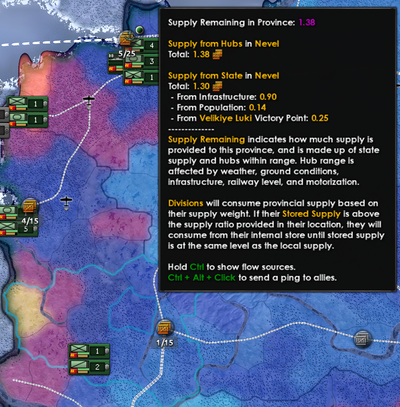
To see how much state supply is available, hover over a province in supply map mode to bring up the province supply tooltip. In this province, we can see there is 0.90 state supply from level 3 infrastructure, 0.14 supply from 831,140 population, and 0.25 from the level 1 victory point in Novgorod.
一个地区拥有胜利点会有0.2的地区补给。然后会有0.05的供应了该地区0.05的胜利点(例如,这个地区有1个1点VP,和1个5VP,会有0.5的补给来自VP,生产0.2的基础和0.3的来自该地区6VP)其中的一些示例见下表:
| VP
|
50
|
20
|
15
|
10
|
5
|
3
|
1
|
| 补给供应
|
2.70
|
1.20
|
0.95
|
0.70
|
0.45
|
0.35
|
0.25
|
基础设施提供了每等级提供0.3补给,只要基础建设未受损(基础设施值见下表)——如果是受损,然而一定数量的地区补给的减少直到破损被修复。
| 基础设施等级
|
5
|
4
|
3
|
2
|
1
|
| 补给供应
|
1.50
|
1.20
|
0.90
|
0.60
|
0.30
|
Population adds supply on a diminishing scale from 0.01 supply per province in a state of 30.000 people, to 4.25 supply per province in a state with 23.6 M people. Converted to per 1 million people, the scale slides from 0.3 supply per million sparsely populated states to 0.18 supply per million in very densely populated states (e.g. Chinese states).
State supply is evenly distributed to all the units that are in the state (including air and naval units), before other sources of supply are used. Given this, it’s important to be mindful that while there might be enough state supply to support any units outside of hub range, those units will still have to share that state supply with units drawing supply from hubs or ports.
File:Supply-033.jpg This collection of screen grabs shows a number of units drawing supply from the state of Murmansk at the same point in time. Note that ships drawing from the port still consume state supply, as do aircraft on the airfield. Note that the armoured division within range of the hub is drawing the same amount of state supply as the armoured division outside of the hub’s range.
Understanding state supply is essential to understanding how the supply map mode “heat map” works – as unlike hub supply, the shading of each province on the heat map takes into account that total amount of state supply available for the whole state - but once that state supply is used elsewhere in the state, the available state supply for other provinces is reduced accordingly. Checking an area to see whether the heatmap shading is due to mostly hub or state supply will provide a clearer indication of the effective supply in the province if more forces are moved into the state in other provinces. Please see the example provided by the two screenshots below for a bit more detail.
File:Supply-031.jpg This tooltip shows that there is 2.75 supply remining in the province. Look closely, however, and notice that it’s all due to state supply – this if that supply is used up elsewhere, once units have moved into the state there will be a lot less actual supply in that province.
File:Supply-032.jpg If we now move in a sizeable force to protect against the border with Italian Libya, the same province that previously had 2.75 supply available now has very little (0.12), because the supply available in the state has been distributed between all of the divisions in that state, leaving only 32% of the division in that province’s requirements.
争议地区
如果一个国家的控制权在两个国家之间相互分裂,国家的供应量将被一分为二。中心、人口和基础设施元素将根据双方所拥有的国家省份的比例进行分配,而来自胜利点的国家供应将提供给任何拥有包含这些胜利点的省份。
File:Supply-034.jpg These screen grabs show how state supply (the only source of supply in this example) changes as Italian forces advance across the state of Matrouh. In the first screen grab, we see total state supply in Mersa Matruh is 2.75 (note that level of rounding for state supply is to one decimal place, even though two are displayed), then in the second it shows that after the Italian forces have 2 provinces, they have access to 22% of the state supply from base, infrastructure and population, as they now control 2 of the 9 provinces in the state. In the third screen grab, the Italians now have four provinces and the victory point at Marsa Matruh, giving them 44% (4 as a proportion of the 9 provinces in the state) of the base, infrastructure and population supply, and all of the 0.25 state supply provided by the single VP at Marsa Matruh.
空投补给
File:Supply-036.jpg Air supply is shown under the “Supply from State” heading in the province supply tooltip, but like state supply, the amount shown is the total available to the whole of the air region. In this case, air supply missions are providing 7.28 air supply to the whole region.
供应系统的三个支柱中的最后一根是空中供应。空中供应由飞行“空投补给”任务的运输机提供。与国家供应一样,通过此提供的供应总量在飞行空中供应任务的任何省份提供(无论是否在运输机的范围内)。然而,与国家供应不同的是,空气供应是最后抽取的,所以单位只有在不能满足国家和补给中心的全部供应要求时才会利用空中补给。
File:Supply-035.jpg Here we see the 2 TrAD Air Wing, comprised of 40 transport aircraft, assigned to air supply in the Northern Front air region. While the range of the transport aircraft does not cover the whole region, the whole region will still receive access to the air supply from this air wing. However, because the transport aircraft cannot cover the whole region, they do receive a penalty to mission efficiency, which affects how much air supply they can provide (and how much supply they require as well).
File:Supply-037.jpg The screengrabs show a number of different situations for units in the “Northern Front” air region. Going from from left to right, in the first a division is in a province with access to some state supply, but no hub supply, and so is “topped up” by air supply. In the second, two divisions are fully covered by state and hub supply, and so don’t draw on any air supply. In the third, the province has nowhere near enough state supply (and no hub supply at all), and air supply is essential to these units being decently supplied. In the fourth, we see that the air wing flying the supply mission, that is flying from within the air zone, and drawing hub and state supply to provide the air supply elsewhere in the zone.
对于任何空中任务,任务效率将减少可以提供的供应,和效率可以受到一系列元素的影响,包括天气,中队执行任务的供应状态的时候,和空气区的大小之间的关系和中队的范围。在100%的任务效率下,每架供应充足的运输机在良好的天气下飞行,能够提供0.2 每飞机提供.
File:Supply-038.jpg Here the 2 TrAD air wing finds itself in rainy weather (-10% mission efficiency) and with 15% of its aircraft disrupted, dropping the supplies provided through air supply from 7.28 down to 6.2.
空气机翼的供应需求是由供应的数量他们能够提供通过他们的任务效率,所以所有其他平等,运输机的翼可以覆盖更大比例的空气区将提供更多的空气供应比相同大小的翼使用不同的机场,给它更少的报道。运输机翼飞行空气供应任务只能使地图和补给中心,不能增加他们自身的空气供应
补给不足的影响
地面单位
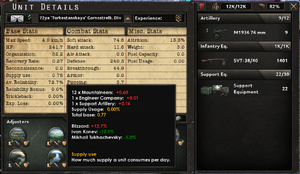
Here we see the supply footprint of the Soviet 72ya Div. Note that the base supply cost (0.77) is a product of its various battalions and support companies, but that it’s been modified up by a blizzard, and down by the supply skills of the army and army group commanders.
一个师为充分供应所需的供应量是基于一系列要素,包括线营、支援营(后勤营减少总供应使用)、天气及其指挥官的能力。
如果一个师的全部供应不足,一个褪色或鲜红色的板条箱图标将出现在其地图上的图标上,以及在军队的师列表中的图标上。要精确地查看一个师的供应状态,请将鼠标悬停在陆军师列表中的图标上,以打开工具提示。A部门的供应将转向在该省可以支持的数额,无论是上升还是下降。,例如,如果一个部门从一个省100%供应去50%供应,第一个小时,新省仍然会有100%供应,然后部门的供应状态将其存储供应下降到50%。
File:Supply-039.jpg Here, the 27ya Division is in a poor state, with just 10% supply status (and only 9% stored supply, which will increase to 10% as long as the province supply for the division doesn’t drop).
缺乏一系列单位特性会受到严重的惩罚。注意,在达到低供应状态和全面处罚之间可能会有一个延迟。机组特性受低供应的影响,随着供应状态的恶化,影响增加,包括:
- 速度
- 最大组织度
- 组织恢复速度
- 攻击(防御单位的最大惩罚(-50%)高于攻击单位(-20%))
- 突破(针对进攻单位)
- 防御(用于防御单位)
- 消耗——如果一个单位的供应水平下降到35%或更少,它将开始采取基本的供应消耗,进一步增加供应的数量来增加该单位使用的设备的数量。
File:Supply-040.jpg The impact of the 27ya Division’s low supply state significantly reduces its movement speed – if it wasn’t for the base game speed of 1km/hr, the speed of the division would be even lower.
File:Supply-042.jpg Here, the somewhat undersupplied British attack the very undersupplied Italians – note the impact on attack and breakthrough/defense of the units on both sides of the combat.
处于低供应状态也会影响人力增援到达的速度。只要一个师通过友好的省份、港口和/或车队与首都相连,人力增援部队就会到达——尽管在非常低的供应水平下,他们可能需要很长时间。然而,注意,设备补给速度不受部门供应状态的影响(但如果一个部门供应不足,只要是这种情况,他们就会经历持续的消耗,这可能会阻止部门达到其完整的设备水平)。
如果一个师与首都被切断,即使是由于占领了一个胜利点或其他国家供应来源,或由于空中补给,它也不会得到人力或设备的增援。
请注意,燃料的工作方式与人力或设备略有不同。和人力和设备一样,如果被切断了与首都的补给,它就不会得到补充。和人力一样,如果一个单元没有完全供应,燃料补给的速度就会减慢。然而,与人力不同的是,一旦供应状态足够差,燃料供应就会完全停止。空中补给不会影响燃料供应,因此即使一个单位可以追踪一条省份到其首都,并且完全空中补给,如果它没有足够的州或枢纽供应,它可能无法得到燃料补给。
File:Supply-041.jpg In the screengrab on the left, the 53rd (Welsh) Infantry Division is at a very low supply status, and it’s going to have to wait nearly a month to be brought back up to strength. In the screengrab on the right, the division has moved into a better-supplied province, and the replenishment is going to happen much sooner.
储存补给/补给延缓
供应延缓和储存的供应是指相同的东西,即如果是在一个供应充足的省份,一个部门将储存的超过100%的供应量。一个师的存储供应量可以在陆军UI元素中悬停在一个师的名称上的工具提示的底部看到,如下例所示。
一个部门可以积累的基本储存供应量是150%。它下降的速率各不相同,但它应该使一个部门能够在完全供应效率下运行2-3天,即使它所在的省份没有完全供应,在储存的供应下降到100%以下之前。
File:Supply-043.jpg Here the French 25th Infantry Division has accumulated its full amount of stored supply.
对于特种部队的师,一些技术可以增加补给时间的长度。这可以进一步扩展到海军陆战队师,如果他们是由一个将军与“两栖”领导。提供的额外补给延缓是以小时来描述的,但这只是广泛的指示,因为存储供应的减少速度可能会根据师所处的情况而不同。
File:Supply-045.jpg Two of the special force technologies can increase supply grace for special forces divisions. The final tech in the tree increases the stored supply in special forces divisions by roughly (it may vary depending on actual conditions) 48 hours.
File:Supply-044.jpg A general with the “Amphibious” trait can give marine divisions a very helpful extra 240 hours (more or less, depending on the division’s circumstances) of stored supply. Note that it can take some time to build up to this level of stored supply.
空中单位
一个空军单位的供应是基于包含空军基地的省的供应水平。如果一个航空单位正在执行任务,而不是100%供应,由于其供应水平降低,它的效率将出现问题。重要的是要记住,如果供应低于一个阈值,空气单位也将得不到足够的燃料,从而进一步降低任务效率。
File:Supply-047.jpg Due to some rather questionable British army deployment orders, the supply to the airbase in South-West England is only sufficient to give 72% supply to the air wing operating from there.
File:Supply-046.jpg Looking at the tooltip for the air unit from the example above, we can see that the impact of being at 72% supply is a 28% penalty on mission efficiency.
海军单位
对于海军单位来说,补给不足会直接影响定位效率和维修速度,但也降低了燃料接收率,这取决于燃料情况,也会影响他们在战斗中的效率。值得记住的是,值得记住的是,海军单位可以从他们所抽取的补给中心获得全部的潜在供应(而不是像陆地和空军单位那样受到该省所能支持的限制),因此,海军单位的供应不足远不如陆地或空军单位常见。
File:Supply-048.jpg In these two screengrabs, the situations are identical except that the British (green) fleet on the left-hand side is at 57% supply, and the British fleet on the right hand side is at 76% supply. Note (as highlighted) that the detection chance has increased with the greater level of supply.
盟国补给
默认情况下,你可以从你的盟友的供应中心获取供应,你的盟友可以从你的供应中心供应。然而,注意,如果你在盟军领土上作战,你就不能使用国家供应系统。盟军师共享土地主人的补给供应,但土地主人的部队供应可能会更好一些,因为他们也将能够获得任何可用的国家供应。
File:Supply-049.jpg Supply-049 – Here, the US task force and the US divisions in Dover draw supply from the British hub, as does the British task force there and a few other British divisions off-screen.
File:Supply-050.jpg On the left, the US divisions in Dover only have access to hub supply, while on the right, the British divisions there have access to both hub supply and state supply, and so are able to maintain a higher supply state.
While the AI won’t do this, if you want allies not to be involved on a particular front, it’s possible to toggle off supply for allies on a hub-by-hub basis. To toggle supply for allies off (or back on) for a particular hub, click on the hub, and then select the blue flag to the left and above the supply hub symbol (see examples below).
File:Supply-051.jpg On the left-hand side, the supply hub is still providing supply to allies. By clicking on the button with the blue flag on it, the situation changes to that on the right, where allies can no longer draw supply from the hub. Notice that there’s a small “do not enter” (red circle with a line through it) on the actual supply hub icon as well. Bear in mind that allied supply has to be turned off hub-by-hub – for Britain to completely deny allied supply in Dover, for example, supply needs to be turned off at the hubs in London, Portsmouth and the nearby port to the north.










